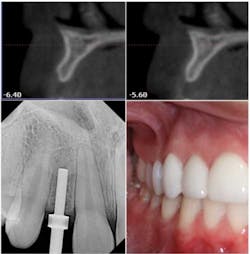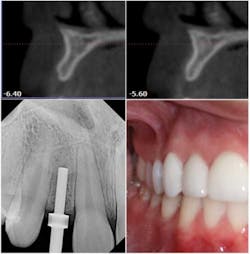Technology and the esthetic outcome for implants
by Justin Moody, DDS
For more on this topic, go to www.dentaleconomics.com and search using the following key words: dental technology, digital radiography, cone beam imaging, implants, panoramic, CBCT, CAD/CAM, esthetic dentistry, Justin Moody, DDS.
Implant dentistry is centered around the desired esthetic outcome. Some call it "working backward" – starting the process by defining how the patient or referring dentist wants it to look and then working toward that goal. The quality of implants and the technology to plan and create them has evolved over the years. In my practice, digital radiography, CBCT, and CAD/CAM milling pave the way for a smooth implant process.
Educating and communicating with patients is imperative. The referring doctor, patient, and I discuss the possibilities to determine whether a simple crown, multi-implant, or removable prosthesis will yield the desired esthetic outcome. Next, I precisely assess the patient's dental anatomy to ascertain whether that desire is realistic. My i-CAT® has become an integral part of my implant regimen.
When placing an implant, I cannot just guess where enough bone is and then wait to see what happens. I need to know definitively that there is enough bone and structure to maintain an implant successfully. If not, the next step is to create the ideal structure through procedures such as bone grafting, or employ a different prosthetic solution. To fulfill the dentist's responsibility for ALARA, each scan size is determined based upon the individual's needs. When taking a CBCT scan, my i-CAT allows for collimation to focus on a particular area of interest.
Digital technology assisting the successful implant case
The ability to access the anatomical structures before starting the implant makes 3-D technology a good investment. The patient's chair time is greatly reduced with 3-D as a diagnostic tool. Without the CBCT scan, whether the patient needs one implant or a full arch of them, bone volume still has to be determined. With a CBCT scan, I will find out the dimension of the bone without taking a blade to the patient.
Patients appreciate that. Even with a 2-D panoramic, I would still have to anesthetize the patient and perform some bone sounding with calipers to find the buccal-lingual width of the bone. The scan illustrates precisely what is under the tissue, and the patient is put through less discomfort for a shorter time.
Today's implant techniques are more esthetically driven, and new technologies are mindful of this esthetic objective. I custom mill ceramic abutments and use IPS e.max® crowns using my E4D crown milling machine. This has been instrumental when preparing implants for the anterior region and designing the crown around the abutments.
Digital technology saves an astronomical amount of surgical time and improves the success of implants. When I can take digital (DEXIS®) PAs during surgery, I am sure that I am navigating between existing teeth and maintaining distance and parallelism. It is invaluable to me to have that information instantaneously. It shortens the time I have to wait with an open surgical site. Again, this is something patients appreciate.
The time, effort, and investment spent on implant planning with technology is well worth it – whether for a single tooth or a large case. The complex technology behind these innovations drives the implant process and makes a beautiful esthetic outcome seem simple.
Dr. Justin Moody is a diplomate with the American Board of Oral Implantology/Implant Dentistry and the International Congress of Oral Implantologists, and an associate fellow with the American Academy of Implant Dentistry. He also holds mastership and fellow status at the Misch International Implant Institute. He can be reached at [email protected].
Past DE Issues

